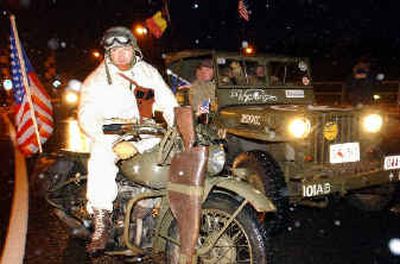Belgium honors WWII veterans

BASTOGNE, Belgium — Amid snow flurries and a chilling wind, Belgium’s King Albert II honored U.S. soldiers who died fighting Nazi Germany 60 years ago in the Battle of the Bulge, the largest land battle for American forces in World War II.
Veterans from across the United States returned Saturday to find this market town much as it was that bitter cold December of 1944 when it was at the center of the fighting – covered in snow and buffeted by wind.
The old soldiers, wearing military berets and caps, were greeted with warm applause, hugs and kisses from a grateful crowd lining the streets.
“I’m very happy to see so many people come out for this event,” said Miasy Dumont, 68, from nearby Ludelange, Luxembourg. “This is the last time, I’m sure. In 10 years there will be no more veterans.”
The king, joined by Speaker of the House Dennis Hastert, R-Ill., led a commemoration and laid wreaths at the vast Mardasson memorial on the edge of town. The ceremony paid homage to the 19,000 American soldiers killed and about 61,000 wounded in the battle. The fighting also claimed 120,000 German lives.
“All soldiers memorialized at this monument are part of the greatest generation,” said U.S. Gen. James L. Jones, supreme allied commander in Europe.
After the half-hour ceremony, which included a U.S. honor guard from the 101st Airborne Division from Fort Campbell, Ky., veterans were driven by bus from the towering memorial back to the center of town.
Once there, they again enjoyed warm applause from crowds lined up from the main street to the town square, and they attended a sound and light show and a parade of World War II vehicles.
The day began with a parade of veterans, marching bands, World War II-era jeeps, trucks and ambulances through Bastogne. The vehicles rumbled past the town’s central square, named for Anthony McAuliffe, the acting commander of the 101st Airborne division, whose paratroopers repulsed repeated attacks.
On Dec. 22, 1944, MacAuliffe was given two hours to surrender by the Germans or face “total annihilation.” His now famous reply: “Nuts!”
A commemorative throwing of nuts was also to take place at the square.
There were guided walks along the defensive perimeter south of Bastogne, an area relieved by Patton’s Third Army when troops rushed north from France to help defeat the Germans. The battle raged for six weeks across the Ardennes hills of southern Belgium and Luxembourg, but the market town of 14,000 bore the brunt of the fighting.
“The American veterans who have returned 60 years later to the battle site represent those who gave their lives on our soil so that today we can live free,” Bastogne Mayor Philippe Collard said in French at a memorial honoring U.S. General George S. Patton.
He added in English, “We will never forget. You are home here.”
Rising out of the Champagne fields of northern France, the Ardennes highlands sweep across southeastern Belgium, cover much of the Grand Duchy of Luxembourg, then flow into western Germany’s Eiffel range.
Sixty years ago, their valleys, trout streams and rolling hills were the scene of Hitler’s last gamble. His panzer divisions smashed through the forests, catching the Allies by surprise and driving the front westward in a “bulge” that ran deep into Belgian territory.
There was so much destruction that it is impossible to know exactly how many people were killed in action, how many went missing and how many were wounded.
The battle drew in more than a million troops – 600,000 Germans, 500,000 Americans and 55,000 Britons – who fought in bitter cold from Dec. 16, 1944, to Jan. 25, 1945.
The Veterans of the Battle of the Bulge in Arlington, Va., says 19,000 American troops died in the battle.
The Mardasson Memorial on the edge of Bastogne is built on the spot where German artillery bombarded the Americans in the town below, honoring the U.S. forces killed and wounded during the Ardennes offensive.
There is also a plaque bearing a Latin inscription saying: “Liberatoribus Americanis Populus Belgicus Memor,” or “The Belgian People Remember Their American Liberators.”